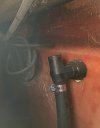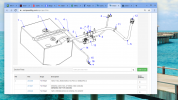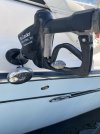I am generally NOT the guy who says "Ask your Grady dealer.." but if I had a brand new 30' Grady and I couldn't put gas in it, I would be a very loud customer.

Luckily, I don't have a new boat.
There is a pretty good thread on THT regarding EPA fuel systems
https://www.thehulltruth.com/boatin...-marine-fuel-tanks-30-reduction-capacity.html
Here is a very interesting picture from that thread.
So what I see it that the main fill vent hose does not go to the canister. The canister and p trap (and thruhull vent) are connected with a smaller hose. When the UNVENTED Fuel Cap is in place, the small vent in the P trap allows for pressure equalization. The Grade valve is also connected with a small hose. Apparently the grade valve helps vent if you are on a trailer and parked on a hill?
The fuel cap is NOT vented. When your cap is removed to fill, the large vent hose comes into play. It is not effected by the canister or p trap at all.
Look at the black things projecting down into the tank. The Vent Valve and Inlet Valve. They are plactic ball float valves that prevent fuel from going up the fill hose and vent hoses.
The vent valve has to be shorter than the fill valve or your vent will close before the fill closes.
These valves reduce the useable capacity of your tank.
So a clogged canister or ptrap SHOULD have no effect on filling the tank.
Now, if your system does not have a large vent hose to the deck fill then you are always screwed.

All of this crap is supposed to reduce the fuel vapor escaping to the atmosphere. But if you are spitting a pint of gas out evry time you fill, its not accomplishing anything.





